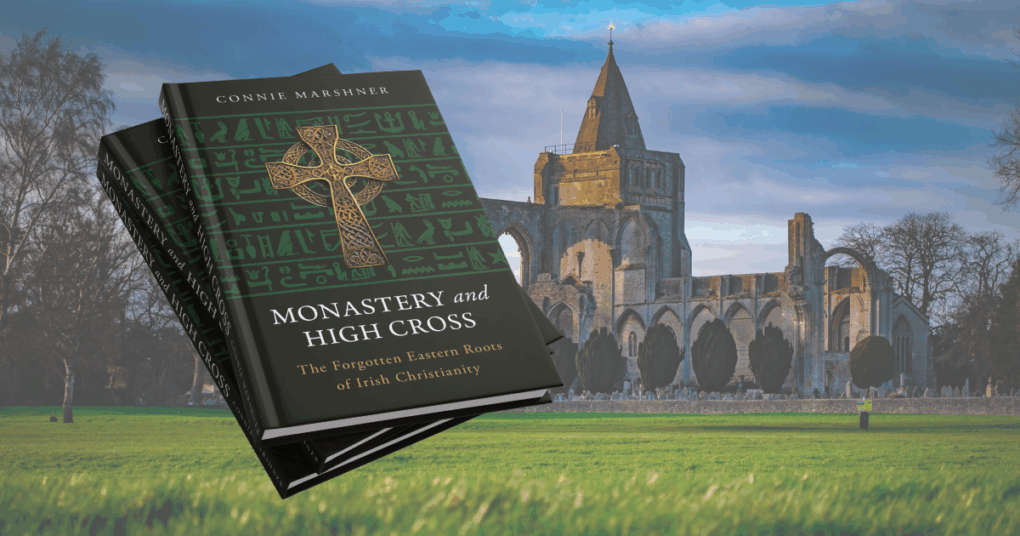The Forgotten Eastern Roots of Irish Christianity
Connie Marshner
Sophia Institute Press
July 2024
256 pages
ISBN: 978-1644137697
This work explores the evangelisation of Ireland before, and perhaps contemporaneous with, St Patrick’s arrival, and thereafter up to the ninth century. It is a presentation drawing on the author’s dissertation, written to obtain her Master of Arts degree at University College Cork, and published by Sophia Institute Press.
This accessible book documents art, architecture, monastic traditions, manuscripts, and liturgy from the earliest times of Christianity in Ireland, finding evidence of influence from Egypt and Armenia. Since the discovery of the “Faddan More Psalter,” so called because it was found in the Faddan More Bog in County Tipperary, which was bound in the style of Egyptian manuscripts and contained some papyrus, scholars have had to take a fresh look at the roots of early Christianity in Ireland, as well as the routes and time frame involved. Although the author does not work with primary sources, the secondary sources are well referenced, and there is an extensive bibliography.
Pre-Christian culture in Ireland is examined initially. Marshner refers to St Patrick’s work of inculturation of the faith and raises the question of prefigurement when drawing attention to aspects of the culture portrayed in Gaelic legends: for example, “often the heroes use words, chants, music, and prayers to accomplish their wonders. The number three was sacred. Celts believed in an afterlife.” All very providential.
In the chapter on “The Church of St Patrick,” she highlights the diversity of rites in the Catholic Church up until the Council of Trent and how the truth of the faith was not compromised by this. St Patrick’s lighting of the Easter Fire seems to be an Eastern custom rather than one brought from continental Europe. “Rome did not celebrate solemn Easter Vespers until after the middle of the seventh century – even though it had long been performed in Constantinople.”
Our vision of Ireland changes from a remote island off the northwest coast of Europe to a place with many trade links by water to the western seaboard and through the Mediterranean. This trade dates back to the second century BC, when copper was mined in Kerry with links to the Iberian Peninsula. In the early Christian period, an Ogham inscription near St Olan’s Well in West Cork cites “pray for Olan the Egyptian.” In the chapter on “Travel and Archaeology,” Marshner cites much evidence of strong links with the Middle East, including church architecture and decoration, the use of book shrines, devotion to the Eucharist, and references in manuscripts.
Tracing the origins of the design of the Celtic Cross to Armenia and linking it to Constantine’s Crux Gemmata is fascinating. Likewise, the Eastern influence on illuminated manuscripts, such as the Book of Kells, is compelling. Monasticism appears to have been transplanted from the Egyptian desert to the “díseart” in many remote places in Ireland: “House of delight built on the rock and indeed true vine transplanted from Egypt,” from the Antiphonary of Bangor. St Anthony of the Desert seems to have been an important saint for these early monks. Marshner suggests that monks fleeing from Islam, and later during the Iconoclast Controversy, may have come to Ireland, bringing their skills, manuscripts, and devotional life.
Some Apocrypha were known in Ireland. Marshner cites a poem to Mary, said to be written in the mid-eighth century on the Harrowing of Hell, which depends explicitly on the apocryphal Gospel of Nicodemus. Devotion to Mary was well rooted among early monks, and a notable detail is that when Adomnán of Iona wrote the first law code to protect women and children, he explained that he did so “for the sake of Mary, the mother of Christ.”
In her closing thoughts, Marshner notes how “angst over pious customs and liturgy has occupied the minds and conversations, and hindered relationships between many faithful Catholics, for three generations now. Angst can sometimes be relieved by knowledge: the Mass was not always in Latin, for instance, yet it was still valid; there was no Rosary in the fifth century, but devotion to the mother of God was abundant and its expression magnificent.”
It makes perfect sense that we were evangelised from the East, as Jesus lived there. But it is intriguing to appreciate the routes by which the faith came and the workings of providence throughout. As Rev. Fr William Fitzgerald, O.Praem., states, “While Connie Marshner indicates which direction further research might take, she has made a major contribution to bringing the question to a juncture from which further research may go forward. Her style of writing is engaging for the reader. I found it hard to put her work aside.”
I wholeheartedly agree with him and highly recommend this book to anyone interested. The untutored will find it fascinating, and the academic may be inspired to further research.
Full Reference for the Book
About the Author: Mary Dooley
Mary Dooley is a retired Primary school teacher with a lifelong interest in Archaeology and History. She received her B. Soc.Sc from UCD and Diploma in Education from St. Patrick’s College Drumcondra( now under DCU). Now lives in Cork.

